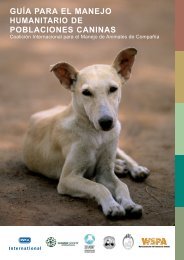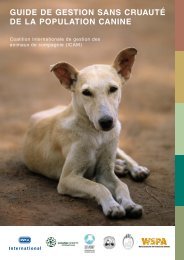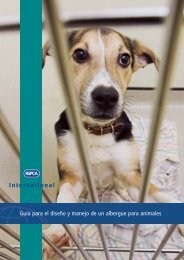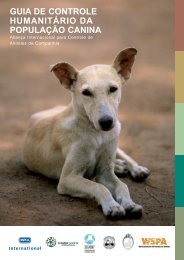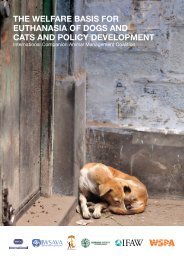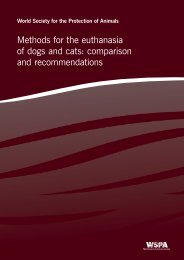HUMANE DOG POPULATION MANAGEMENT GUIDANCE - ICAM ...
HUMANE DOG POPULATION MANAGEMENT GUIDANCE - ICAM ...
HUMANE DOG POPULATION MANAGEMENT GUIDANCE - ICAM ...
Create successful ePaper yourself
Turn your PDF publications into a flip-book with our unique Google optimized e-Paper software.
Introduction<br />
All the organisations within the <strong>ICAM</strong> Coalition seek to<br />
improve animal welfare as a common purpose, and as a<br />
priority. Dog population management is an area of concern for<br />
all of us due to the welfare issues involved.<br />
Roaming dogs may encounter a range of welfare problems,<br />
including:<br />
malnutrition<br />
disease<br />
injury through traffic accidents<br />
injury through fighting<br />
abusive treatment.<br />
Attempts to control the population may also present significant<br />
welfare problems, including:<br />
inhumane methods of killing such as strychnine poisoning,<br />
electrocution and drowning<br />
cruel methods of catching<br />
poorly equipped and managed holding facilities.<br />
Within any population of dogs there will be different categories<br />
of ownership. These are:<br />
owned with restricted movements<br />
owned and allowed to roam<br />
unowned.<br />
There will be welfare issues relating to both restricted and<br />
roaming dogs. However, for the purposes of this document,<br />
the aim of dog population management is defined as: “To<br />
manage roaming dog populations and the risks these may<br />
present, including population size reduction when this is<br />
considered necessary”.<br />
Whether reducing the size of a roaming dog population is<br />
considered necessary will, to some extent, be subjective. In<br />
each situation there will be some people willing to tolerate<br />
roaming dogs and others who will not. For example, some<br />
members of the public and government authorities are<br />
concerned with public health and safety problems associated<br />
with roaming dog populations, including:<br />
transmission of disease to humans (zoonoses) and other<br />
animals<br />
injury and fear caused by aggressive behaviour<br />
nuisance through noise and fouling<br />
livestock predation<br />
causing of road traffic accidents.<br />
On the other hand, in some countries roaming dogs may be<br />
valued, owned animals that are allowed to roam unrestricted<br />
by the local community. A reduction in their numbers may be<br />
neither necessary nor wanted, but improving the welfare and<br />
health of the population and reducing zoonotic risks may still<br />
be recognised as beneficial and desirable.<br />
A roaming dog can be either owned or unowned. It is the<br />
responsible ownership of a dog that prevents it being<br />
considered a problem by other members of the community.<br />
This document considers management options that address<br />
both categories (owned and unowned) of dog.<br />
Owned roaming dog in Portugal.<br />
RSPA International<br />
04



